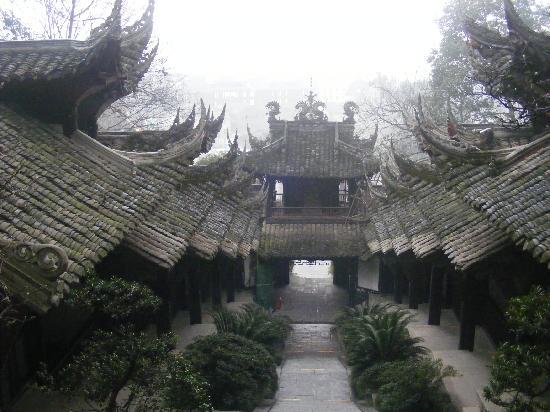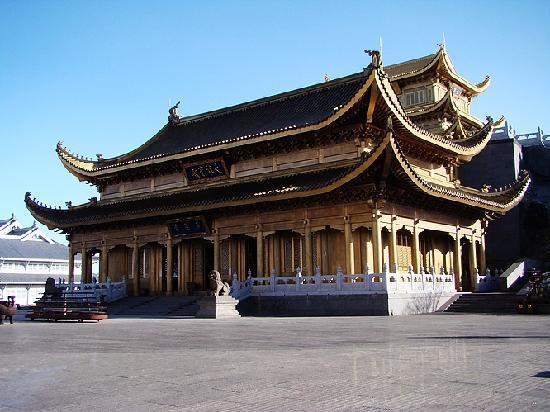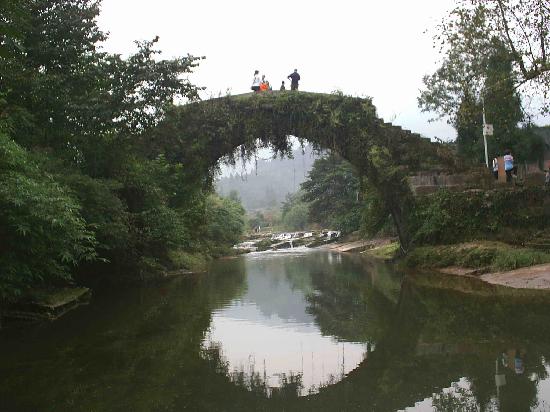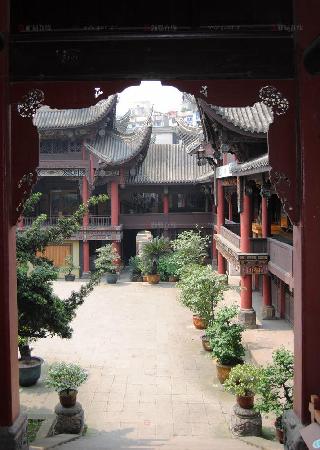| ||||||||
| ||||||||
History
The territory of the province and its vicinity were the cradle of unique local civilizations, which can be dated back to at least the fifteenth century BC (i.e. the later years of Shang Dynasty). Beginning from the ninth century BC, Shu (today Chengdu) and Ba (today Chongqing City) emerged as cultural and administrative centers where two rival kingdoms were established.
Shu’s existence was unknown until an archaeological discovery in 1986 at a small village named Sanxingdui in Guanghan County. It is believed to be an ancient city of the Shu Kingdom, where excavations have yielded invaluable archaeological information.
Although the Qin Dynasty happened to destroy the civilizations of Shu and Ba, their cultures were preserved and inherited by people in Sichuan until today. The Qin government accelerated the technological and agricultural advancements of Sichuan making it comparable to that of the Huang He (Yellow River) Valley. The Dujiangyan Irrigation System, built in the 3rd century BC under the inspection of Li Bing, was the symbol of modernization of that period.
Various ores were abundant. Adding to its significance, the area was also on the trade route from Huang He Valley to foreign countries of the southwest, especially India.
Military importance matches the commercial and agricultural values. As the area is actually a basin and is surrounded by the Himalayas to the west, the Qinling Range to the north and mountainous areas of Yunnan to the south, its climate is often heavily foggy. Since the Yangtze flows through the basin and thus is upstream to areas of eastern China, navies could be easily sailed downstream. Therefore the area was bases of numerous ambitious militarians and refuges of Chinese governments throughout history.
Sichuan’s borders have remained relatively constant for the past 500 years. This changed in 1997 when the city of Chongqing as well as the surrounding towns of Fuling and Wanxian was formed into the new Chongqing Municipality.
 Chengdu Chengdu
|
 Ngawa Ngawa
|
 Chengdu Chengdu
|
 Zigong Zigong
|
 Ya′an Ya′an
|
 Leshan Leshan
|
 Garze Garze
|
 Chengdu Chengdu
|
 Leshan Leshan
|
 Ya′an Ya′an
|
 Zigong Zigong
|
 Ngawa Ngawa
|
Anyue County(安岳县)
Bazhong City(巴中市)
Barkam City(马尔康市)
Baiyu County(白玉县)
Batang County(巴塘县)
Butuo County(布拖县)
Beichuan Qiang Aut. County(北川羌族自治县)
Baoxing County(宝兴县)
Chengdu City(成都市)
Chongzhou City(崇州市)
Cangxi County(苍溪县)
Changning County(长宁县)
Dazhou City(达州市)
Deyang City(德阳市)
Dujiangyan City(都江堰市)
Dayi County(大邑县)
Dazhu County(大竹县)
Danba County(丹巴县)
Daofu County(道孚县)
Dege County(德格县)
Daocheng County(稻城县)
Derong County(得荣县)
Dechang County(德昌县)
Danleng County(丹棱县)
Daying County(大英县)
E′meishan City(峨眉山市)
Ebian Yi Aut. County(峨边彝族自治县)
Fushun County(富顺县)
Guang′an City(广安市)
Guangyuan City(广元市)
Guanghan City(广汉市)
Garze County(甘孜县)
Ganluo County(甘洛县)
Gaoxian County(高县)
Gongxian County(珙县)
Gulin County(古蔺县)
Huaying City(华蓥市)
Heishui County(黑水县)
Hongyuan County(红原县)
Huili County(会理县)
Huidong County(会东县)
Hongya County(洪雅县)
Hanyuan County(汉源县)
Hejiang County(合江县)
Jiangyou City(江油市)
Jianyang City(简阳市)
Jiuzhaigou County(九寨沟县)
Jinchuan County(金川县)
Jintang County(金堂县)
Jiulong County(九龙县)
Jiange County(剑阁县)
Jingyan County(井研县)
Jiajiang County(夹江县)
Jinyang County(金阳县)
Jiang′an County(江安县)
Junlian County(筠连县)
Kangding City(康定市)
Kaijiang County(开江县)
Leshan City(乐山市)
Luzhou City(泸州市)
Langzhong City(阆中市)
Lixian County(理县)
Luding County(泸定县)
Luhuo County(炉霍县)
Litang County(理塘县)
Linshui County(邻水县)
Leibo County(雷波县)
Longchang City(隆昌市)
Lushan County(芦山县)
Lezhi County(乐至县)
Luxian County(泸县)
Meishan City(眉山市)
Mianyang City(绵阳市)
Mianzhu City(绵竹市)
Maoxian County(茂县)
Muchuan County(沐川县)
Mabian Yi Aut. County(马边彝族自治县)
Muli Tibetan Aut. County(木里藏族自治县)
Mianning County(冕宁县)
Meigu County(美姑县)
Miyi County(米易县)
Nanchong City(南充市)
Neijiang City(内江市)
Ngawa County(阿坝县)
Nanjiang County(南江县)
Ningnan County(宁南县)
Nanbu County(南部县)
Panzhihua City(攀枝花市)
Pengzhou City(彭州市)
Pingchang County(平昌县)
Pujiang County(蒲江县)
Puge County(普格县)
Pingwu County(平武县)
Peng′an County(蓬安县)
Pengxi County(蓬溪县)
Pingshan County(屏山县)
Qionglai City(邛崃市)
Quxian County(渠县)
Qingchuan County(青川县)
Qianwei County(犍为县)
Qingshen County(青神县)
Renshou County(仁寿县)
Rongxian County(荣县)
Suining City(遂宁市)
Shifang City(什邡市)
Songpan County(松潘县)
Shiqu County(石渠县)
Seda County(色达县)
Santai County(三台县)
Shehong County(射洪县)
Shimian County(石棉县)
Tongjiang County(通江县)
Tianquan County(天全县)
Wanyuan City(万源市)
Wenchuan County(汶川县)
Wusheng County(武胜县)
Wangcang County(旺苍县)
Weiyuan County(威远县)
Xichang City(西昌市)
Xiaojin County(小金县)
Xinjin County(新津县)
Xuanhan County(宣汉县)
Xinlong County(新龙县)
Xiangcheng County(乡城县)
Xide County(喜德县)
Xichong County(西充县)
Xingwen County(兴文县)
Xuyong County(叙永县)
Ya′an City(雅安市)
Yibin City(宜宾市)
Yajiang County(雅江县)
Yuechi County(岳池县)
Yanyuan County(盐源县)
Yuexi County(越西县)
Yanting County(盐亭县)
Yingshan County(营山县)
Yilong County(仪陇县)
Yanbian County(盐边县)
Yingjing County(荥经县)
Yibin County(宜宾县)
Ziyang City(资阳市)
Zigong City(自贡市)
Zamtang County(壤塘县)
Zoige County(若尔盖县)
Zhongjiang County(中江县)
Zhaojue County(昭觉县)
Zitong County(梓潼县)
Zizhong County(资中县)
 Xiyuan Hotel
Xiyuan Hotel
 Meike Meijia Chain Hotel (Ningyuanqiao S
Meike Meijia Chain Hotel (Ningyuanqiao S
 Yiqingyuan Rice Flour Shop
Yiqingyuan Rice Flour Shop
 Sinopec Huili Wuguan Fuel Station
Sinopec Huili Wuguan Fuel Station
 Longji Barbecue
Longji Barbecue
 PetroChina Sigong Liban Fuel Station
PetroChina Sigong Liban Fuel Station
 Agricultural Bank of China Chang′a
Agricultural Bank of China Chang′a
 No. 31 Bar
No. 31 Bar
 Embassy of United States in Chengdu
Embassy of United States in Chengdu
 Embassy of Germany in Chengdu
Embassy of Germany in Chengdu
 Consulate of Sri Lanka in Chengdu
Consulate of Sri Lanka in Chengdu
 Consulate-General of France in Chengdu
Consulate-General of France in Chengdu
 Consulate-General of United States of Am
Consulate-General of United States of Am
 Ethnic group and Tourism of Sichuan
Ethnic group and Tourism of Sichuan
 Culture of Sichuan
Culture of Sichuan
 Economy of Sichuan
Economy of Sichuan
 Geography , climate and Administrative S
Geography , climate and Administrative S
 History of Sichuan
History of Sichuan

